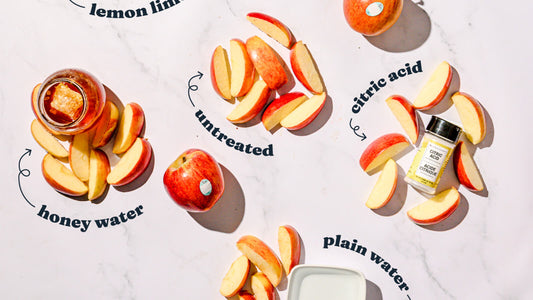by Caroline Fey, chef, culinary consultant, and cooking school instructor. Learn more at carolinefey.com and @carolinefey.
The apple tasting process is very similar to tasting wine. Apple varieties are incredibly different, and each varietal has a wide-ranging flavor profile that is far more complex than just sweet or tart.
Getting Started
When I’m getting ready to taste apples, I always start with a little bit of research. It’s best to begin by setting the apples up in order of tart to sweet, so that you’ll really be able to pick up the nuances of each apple’s flavor profile. Luckily, Yes! Apples uses a sweet-tart scale on their website and a chart on Instagram that shows their apples in order of most sweet to most tart. Using that as a reference, I set my apples on a cutting board with a glass of water next to me. It’s always helpful to be able to clean your palate when tasting, and water is key.
I recommend tasting six to eight apples at a time. The more apples you add, the harder the tasting will become, because too many apples at the same time begins to overwhelm your palate. Six to eight apples is the perfect number. There are three main steps to wine tasting, and I follow the same principles here. 1: observing, or looking at and feeling fruit; 2: scent, or smelling the fruit; and 3: the palate, or tasting the fruit. Make sure to have a notepad next to you if you want to do an in-depth study.
Step 1: Observing
Start by feeling the apples in their natural state, whole and with the skin on. Smell their skin and see if you notice any small differences in their scent. Some are more floral and others have a deep, rich apple aroma.
Step 2: Scent
Next, I cut off one quarter of each apple, and then cut that quarter into a few slices. Look at the color of the flesh and smell the apple's fragrance. What do you see and smell? Place the cut apple slices next to the remaining apple and put a little label next to it with the apple name. That way, you’ll know what you’re tasting, and you won’t lose track of which apple slice belongs with what apple. Also, when you’re tasting each apple, you can look at the color and smell the fragrance at the same time. Tasting is very sensory, and the more senses that you can use to taste, the better.
Step 3: Palate
When tasting wine, best practice is to take a sip and then breath in through your nose or mouth. The air, mixed with the wine, helps to really bring out the flavors of the wine. The same is true when tasting apples. Take a bite, breathe in through your nose, close your eyes, and really try to taste the apple. See what flavors jump out at you. Does it taste like honey? Or lemon? Or even grape, almond, or bubble gum? Is it buttery and creamy, or crisp and very juicy? Is it sweet? How sweet? Is it tart? How tart? What do you taste first?Then, move on to the next apple in your lineup. What does it taste like? How different is it from the first apple, and what makes it different? Tasting apples side-by-side is the best way to be able to pick up little nuances in each apple flavor profile. Repeat this process until you’ve tasted all of the apples.

Once you’ve tasted through all of the apples, take a little break and then taste them again, in the reverse order. See if you notice any small differences that you may have missed the first time.
If you keep notes, then at the end of this process you’ll have an idea of which apples you like best, and what you would use them for. So the next time you go to the grocery store or farmers market, you’ll know exactly what apples you want to buy.







